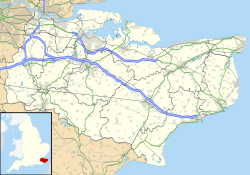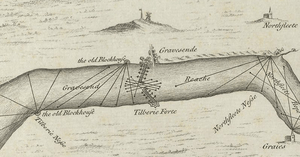Milton Blockhouse facts for kids
Quick facts for kids Milton Blockhouse |
|
|---|---|
| Gravesend, Kent | |
| Coordinates | 51°26′37″N 0°22′48″E / 51.44348°N 0.38008°E |
| Type | Device Fort |
| Site information | |
| Condition | Destroyed |
| Site history | |
| Materials | Stone and brick |
The Milton Blockhouse was a strong fort built with cannons. It was part of King Henry VIII's plan in 1539 to protect England. This plan was made because people worried about an invasion.
The blockhouse was built at Milton, near Gravesend in Kent. This spot was very important along the River Thames. By 1540, the fort was ready to be used. It had 30 cannons and a small group of 12 soldiers and a captain.
The fort was likely a D-shaped building with two floors. Its job was to stop enemy ships from sailing up the river. It also prevented invaders from landing. The cannons were taken away in 1553. The fort was then torn down between 1557 and 1558. Today, nothing of the building can be seen above ground. However, archaeological investigations in the 1970s found parts of its foundations.
Contents
Why Was Milton Blockhouse Built?
Milton Blockhouse was built because of problems between England, France, and the Holy Roman Empire. This happened during the last years of King Henry VIII's rule.
Before this, England usually let local lords defend the coast. The king did not build many forts. France and the Empire were often fighting each other. This meant a real invasion of England seemed unlikely. There were some small forts in the south and north. But generally, England's defenses were not very strong.
In 1533, Henry VIII decided to end his long marriage to Catherine of Aragon. He wanted to marry again. This made Pope Paul III very angry. Catherine was the aunt of Charles V, the Holy Roman Emperor. He saw the annulment as a personal insult. Because of this, France and the Empire joined forces against Henry in 1538. The Pope even told them to attack England. An invasion of England now seemed very likely.
Henry VIII's Defence Plan of 1539
In 1539, King Henry VIII gave an order called a "device". This order gave instructions for "defending the country in time of invasion." It also called for building forts along the English coast.
As part of this plan, the River Thames was protected. A group of forts worked together to defend it. These forts were at Gravesend, Milton, and Higham on the south side of the river. On the other side, there were forts at Tilbury and East Tilbury.
These forts were placed in very important spots. London and the new royal shipyards at Deptford and Woolwich could be attacked by sea. The Thames estuary was a major shipping route back then. About 80 percent of England's goods for export went through it.
The village of Milton and the nearby town of Gravesend were very important for travel. They were only about 500 meters apart. They were the main points for people traveling by "Long Ferry" into London. They also had the "Cross Ferry" that went over the river to Tilbury. This meant the riverbanks were full of wharfs (docks). This area was also the first place invaders could easily land along the Thames. Before this point, the muddy riverbanks made landings very hard.
Building the Fort
The Milton Blockhouse was designed by James Nedeham, who worked for the King. Christopher Morice, the Master of Ordnance, also helped. Robert Lorde managed the money for the project. Local supervisors included Lionel Martin, John Ganyn, and Mr Travers.
The fort was built on Chapel Field. The King bought this land, along with land for Gravesend Blockhouse, for £66. This field used to belong to a church called Milton Chantry. King Henry VIII had closed down this church during the Reformation.
The work was done very quickly. By 1540, the blockhouse was ready to be used. It had 30 cannons, 6 handguns, and many pikes and longbows. Captain Sir Edward Cobham was in charge at first. The fort had a small group of 12 men. This included a second-in-command, a porter, three soldiers, and seven gunners. If the fort were attacked, more soldiers would have come to help.
After 1544, people worried about invasion again. So, Sir Richard Lee, a famous military engineer, did more work on the blockhouse. However, peace was declared the next year.
We are not completely sure what the fort looked like. But archaeological digs suggest it was probably D-shaped. It was likely two stories tall, with a round part facing the river. There would have been places for cannons on both sides of the main defenses. A more modern, angled part was added later on the land side. By 1546, the King's accountants estimated that £1,072 had been spent on building and improving the fort. This was a very large sum of money at the time.
The Fort's End
In 1553, orders were given to remove the cannons from the blockhouse. They were taken to the Tower of London. The fort was then torn down between 1557 and 1558. The bricks and stones from the site were used to repair the Tower of London.
The exact spot of the fort was probably found again during digs in 1826. But it was later destroyed when the Gravesend Canal Basin, Canal Road, and Gordon Pleasure Gardens were built in the 1800s. Archaeological investigations between 1973 and 1978 uncovered the foundations of the blockhouse. Today, these foundations are protected under UK law as a scheduled monument.



